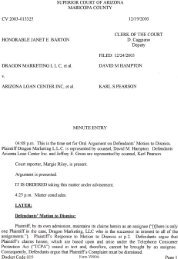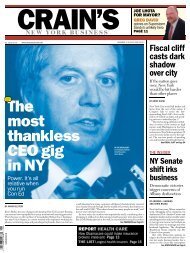Big Plans Up North - American Business Media
Big Plans Up North - American Business Media
Big Plans Up North - American Business Media
- No tags were found...
You also want an ePaper? Increase the reach of your titles
YUMPU automatically turns print PDFs into web optimized ePapers that Google loves.
Once on the ground, those companies are finding thatwhat really counts in Quebec’s north are relationshipswith the Cree, the Inuit, and the Innu. Recent treaties andlaws have shifted control over future development fromthe provincial government to the province’s 33,000 nativepeoples, known in Canada as First Nations. The aboriginalgroups have tapped sophisticated counsel to representtheir interests. Gowling Lafleur Henderson has advisedthe 16,000-member Cree’s central authority in that nation’s quest forgreater control over its territory, and has worked on two model agreementswith mining companies. Two Quebec regional corporate firms,Cain Lamarre Casgrain Wells and BCF, have won mandates to representthe Innu, a 16,000-member group with unresolved claims over northeastQuebec and western Labrador, in four other benefits agreements. Oppositethem, representing the mining companies, are lawyers from FraserMilner Casgrain (FMC), Fasken Martineau DuMoulin, Heenan Blaikie,and others. (The 10,000-member Inuit, for their part, have mostlylooked to their longtime outside solo counsel and in-house counsel.)The aboriginal peoples of northern Quebec are using their new leverageto strike profit-sharing and benefits agreements. In some casesthey can make or break a deal. The deals they have reached are expectedto steer billions of dollars in revenues to the groups while protectingtheir hunting and fishing lands and waterways. “You’ve got high pricesfor ores, high demand from China and Asia,” says Stikeman Elliott’sErik Richer La Flèche, cohead of the practice group that advises clientson collaborative projects between public sector authorities and privateinvestors. “All of a sudden First Nations are settling land claims. You’vegot second- and third-generation college-educated First Nations negotiatorswho are looking at economic development in a new way.”TFasken Martineau’sJean Gagné (left)negotiated with thegovernment and theCree to make wayfor an enormousgold mine projectnear James Bay.he three largest groups, the Cree, the Inuit, andthe Innu, differ greatly in culture, history, and politicalorganization—and, importantly, in their historic relationshipwith the provincial and federal governments. TheCree, whose rights to lands north of the 49th parallel are recognized bytreaty and expanded via subsequent agreements, still hunt and trap moose,caribou, and geese in traditional ways. For jobs and income, however, theyrely increasingly on the power and mining sectors. The Inuit, who havetraditionally lived at the edge of the sea ice as hunters and fishermen, likewisenow have a growing stake in infrastructure and minedevelopments in Nunavik, their recognized territory northof the 55th parallel.The Cree and Inuit are in a stronger negotiating positionvis-à-vis development than the Innu, who claim as ancestralhunting and fishing lands the northeastern region known asCôte-Nord. Quebec has not signed a land treaty with theInnu, although in the past decade four Innu communitieshave reached preliminary land rights agreements with the province.To add to the complexity, some areas, particularly around the LabradorTrough, are subject to overlapping land claims. “It’s something Ihave to tackle on many matters,” says Ann <strong>Big</strong>ué, an aboriginal law partnerwho joined FMC in 2010 after two decades at McCarthy Tétraultand a stint at regional firm Lavery, de Billy.Beyond knowledge of treaties, Quebec’s aboriginal law specialistshave cultivated long relationships with the First Nations. They are familiarwith local cultural norms. For instance, “You’ve got to be sensitiveto the hunting season,” explains <strong>Big</strong>ué. Among the Cree, work stopsfor moose hunting in the fall, and for goose hunting in the spring. “Itreally is a time when people will not be available for meetings,” <strong>Big</strong>uésays. Likewise, she adds, “If you have to break the ice to ship materialsto a development in Inuit territory, for instance, they are very sensitiveto this. They see the ice as land.”That kind of deference to aboriginal culture in Montreal’s officesand boardrooms is relatively recent. It is in large part due to a gamechangingbattle over development in the early 1970s waged by the Creeand the Inuit with the help of a Montreal lawyer, James O’Reilly. Theclash began when the public utility Hydro-Québec, without consultingthe two groups, broke ground on a giant hydroelectric dam near JamesBay, in territory claimed as ancestral land by both.In 1972 O’Reilly was a lawyer at Martineau Walker (a predecessor ofFasken Martineau), which represented the entity developing the dam.But when the Cree asked him to represent them in fighting the project,O'Reilly left the firm. He’s been representing the Cree, and morerecently the Innu and other groups across Canada, ever since; he hasmentored a generation of lawyers at his firm, now known as O’Reilly& Associés, who have gone on to represent the aboriginal groups.With O’Reilly’s help, the Cree and the Inuit won an injunction in1973 that blocked the dam’s construction. The injunction was overturned,and the dam eventually built; but the court’s initial grant of thecourtesy of Fasken Martineau (2)otto steiningerinjunction led to intensive negotiations in 1974–75 between the Cree,the Inuit, Canada, and Quebec. The result, negotiated with O’Reilly’shelp, was the first modern land claims treaty in Canada, formalized in a450-page, 30-chapter behemoth known as the James Bay and <strong>North</strong>ernQuebec Agreement. “We lost that battle at [Canada’s] Supreme Court,”O’Reilly recalls. “But without that [first] injunction, there would nothave been a land claims settlement.”The treaty was just the first in a string of agreements and high-valuesettlements with the province and Canada that have steadily increasedthe Cree’s leverage over development, while helping to empower otheraboriginal groups. Ultimately, in 1982, Canada’s Constitution wasamended to require the government to respect the aboriginal and treatyrights of aboriginal peoples.The Cree were not shy about using their new clout. Cree oppositionin the courts—with O’Reilly as counsel—and use of the media and protesttactics all contributed to Quebec’s 1994 decision to pull the plugplan nord’s reachQuebec’s Plan Nord aims to kick-start development north of the 49th parallel, a vastterritory that encompasses lands claimed by the Cree, the Inuit, and the Innu.on another gigantic hydroelectric project on the southeast shore ofHudson Bay, the Great Whale Project. And throughout the 1980s and1990s, the Cree went to court to enforce provisions of the James Baytreaty that they said weren’t being respected. They relied on O’Reillyand Robert Mainville and Johanne Mainville at Gowling, both alumniof O’Reilly’s firm. (They are both judges now.) Led by Robert Mainvilleand assisted by attorney John Paul Murdoch, a Cree, in 2002 the Creenegotiated a new agreement with Quebec known as the “La Paix desBraves.” The agreement established a new nation-to-nation partnershipbetween the Cree and Quebec, providing for a sharing of revenues andjoint management of natural resources.But conflicts arose again after Quebec in 2001 suddenly altered thegovernance system in the James Bay Cree territory, shifting control tononnative municipal councils. For eight years, the Cree leadership attemptedunsuccessfully to get the provincial government to the tableto change the system. Finally, in September 2009, the Cree voted to goahead with a long-threatened lawsuit.Coincidentally, the Liberal Party’sJean Charest, then newly elected aspremier, had recently announced hisPlan Nord. Calling the plan a “historicopportunity for the governmentand the Cree to move forward together,”the Cree’s leader, Matthew CoonCome, seized the opportunity to pushfor a resolution of the governancedispute. In a meeting with Charest inNovember 2009, the Cree’s positionwas clear: “If you want economic developmentin our territory, there hasto be a good governance regime inplace,” recalls Gowling’s John Hurley,who advised the Cree in subsequentnegotiations. (Hurley’s ties to theCree date back to the 1970s disputeover the Hydro-Québec dam, whenhe was a junior research assistant tothe O’Reilly-led team negotiating forthe Cree. He went on to practice atByers Casgrain and its successor FMCbefore joining Gowling in 2009.)With Hurley at their side, the Creebegan intensive negotiations withQuebec in 2010. In May 2011 theCree and Quebec signed a preliminaryagreement; a final one was signed inJuly 2012. Under the agreement, theCree now have increased autonomyand powers over land and resourceuse and planning on certain lands, andshare joint authority on the rest of theterritory through a regional governmentcomposed of an equal numberof representatives from the Cree andtheir nonaboriginal neighbors.Meanwhile another O’Reilly protégé,Gowling’s François Dandonneau,40, and Cree lawyer Murdoch wereadvising the Cree on the brass-tacksbusiness of reaching benefits agreementswith mining companies. Afterworking as an associate for O’Reilly,62 November 2012 | americanlawyer.com The <strong>American</strong> Lawyer | November 2012 63
FMC’s Ann <strong>Big</strong>ué saysthat companies “shouldstart early and build asolid relationship” withaboriginal communitiesnear development sites.Dandonneau worked in-house for a decade at the MohawkCouncil of Kahnawake, then joined Gowling in2008 and has been one of the Cree’s principal dealsideadvisers ever since.In February 2011, after three years of negotiations,the Cree, advised by Dandonneau and Murdoch,signed an agreement with Goldcorp Inc. allowing thedevelopment of one of <strong>North</strong> America’s largest gold deposits: the massive$2.1 billion Éléonore mine near James Bay. The first private participationdeal between a mining company and the Cree since the Paixdes Braves, the agreement promises the Cree both fixed payments anda share of future profits at Éléonore, and ensures that the project willproceed in a way that protects the Cree’s traditional activities and territory.Last year Goldcorp awarded the first $50 million in contracts; 80percent of this amount went to Cree businesses. The company has saidit hopes to use this agreement as a model for collaboration with localcommunities near its projects around the world.According to Fasken’s Jean Gagné, who represented Goldcorp,Éléonore is a model in yet another way: as a template for future financingof infrastructure. In 2009 Goldcorp asked the governmentfor help financing a road, airstrip, power line,and telecommunications facility. The Charest governmentwas torn: “The government wants to encouragethe building of infrastructure, but it doesn’t really wantto pay for it,” Gagné says. He and a colleague, Jean Masson,came up with a new funding mechanism that theysay became part of the rollout of Plan Nord: Under it, aportion of mining royalties helps underwrite infrastructurefor new development.Since the Éléonore agreement, the Cree have signedoff on other major projects. In late March, the StornowayDiamond Corporation secured a similar deal withthe group that allows Quebec’s first diamond mine, theRénard Diamond Project, to move forward. Reserves arethought to be worth $4 billion. Once again, Dandonneauwas on the Cree side of the table.Stornoway, for its part, looked to Ann <strong>Big</strong>ué. TheFMC partner, who declined to confirm her involvementin the project or any other current client matter, is oftencited as among Quebec’s most experienced aboriginallaw attorneys. Her aboriginal law practice dates backto the late 1970s, when she worked on pipeline projectsat Canada’s National Energy Board. Those projects ranafoul of lands claimed by aboriginal groups; <strong>Big</strong>ué focusedon resolving the conflicts.In the 1980s and 1990s, <strong>Big</strong>ué led some complexlitigations opposite the Innu in the context of hydroelectricdevelopment on behalf of Hydro-Québec, andforestry management activities on behalf of Kruger Inc.But these days, most of her time is devoted to negotiatingagreements with aboriginal groups on behalf of herclients. Companies “should start early and build a solidrelationship,” she says. “To reach agreement, you needto get to know each other. It takes time, and it’s got to bedone properly.”It’s a job that can be physically challenging. A nativeof Abitibi, a sparsely peopled land of boreal forest sevenhours’ drive northwest of Montreal, <strong>Big</strong>ué is no strangerto frigid weather. But she remembers being so cold onsome early trips north to Nunavik, an area of permafrost,that she wore her parka to bed. Another time, afterwalking alone and unarmed to a neighboring house in aseaside village, she was told never to do that again, sincepolar bears were known to attack in the area.Still, “you tend to forget the difficulties,” <strong>Big</strong>ué says,“because I’m always learning. This is an area of the lawwhere you have to be creative. The rules have evolved,and they have been defined and redefined and expandedupon by the courts. We have learned to find a consensusaround each individual project, and to reconcile the interests of developmentand the uses of the land by the aboriginal peoples.”Creativity will certainly be required by Fasken’s Gagné if he is to finda path forward for his new client, Quebec-based Strateco Resources Inc.The company is trying to get a construction permit for a uranium minein Cree territory; but in August the Cree leadership, again representedby Gowling, flexed its political muscle, declaring a permanent moratoriumon uranium exploration and mining on its lands. While Stratecosaid that it would keep talking with the Cree, a courtroom showdown ispossible; Strateco’s most recent statement noted that only the Quebecgovernment may declare such a moratorium. (Gowling’s Dandonneauand Hurley declined to comment.)64 November 2012 | americanlawyer.com
















